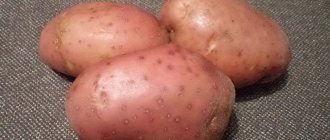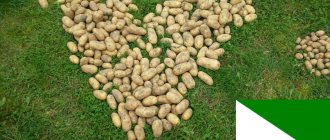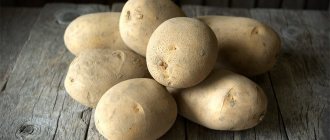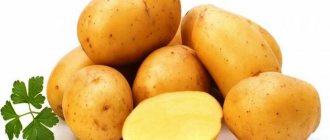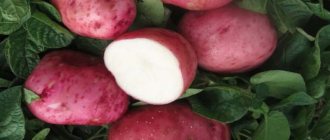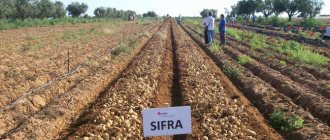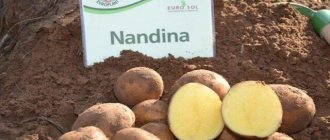Have you ever thought that each potato variety reacts differently to heat treatment? For example, one produces an unusually tender puree, but when frying it completely loses not only its color, but also its taste. The other, on the contrary, is completely unsuitable for cooking, but when fried, it’s simply lickable. How can you go wrong with choosing the most delicious potatoes, which are ideal for preparing this or that dish, and how to grow your favorite variety in your own garden?
Which potatoes taste better?
The taste of potatoes largely depends on the time it takes to ripen - the sooner the tubers ripen, the less starch they will contain, which will affect the taste of the fruit. Therefore, late varieties are considered much tastier than early ones, although among the latter there are also many tasty and nutritious ones.
Yellow potato varieties are rich in carotene - they are quite sweet, tasty and not too boiled. Red ones contain many antioxidants, have a delicate taste and store well. And white ones contain a large amount of vitamin C and starch, they are juicy and boiled.
Potato tubers combine all the substances necessary for the human body: they are rich in potassium, copper, manganese, phosphorus, nicotinic, panthenolic and caffeic acid. In addition, potatoes are a storehouse of vitamin B6, flavonoids and carotenoids.
Sweet varieties
Some varieties have a pronounced sweetish taste, which is felt with any type of heat treatment. Some people like this taste of potatoes, while others, on the contrary, tend to avoid buying sweetish varieties.
Do not confuse the natural sweetish taste of potatoes with the sweetness that appears when frozen - in the first case, the taste of the vegetable is determined by genetic characteristics, and in the second it is a consequence of non-compliance with storage conditions.
Adretta is an early variety characterized by high resistance to diseases and unfavorable climate. Once upon a time, this variety made a real revolution, because before its appearance, all yellow potatoes were considered tasteless and were used exclusively for feeding livestock. The peel and tubers are dark yellow. The taste of this potato is not lost even after long-term storage; when it freezes, it does not acquire an unpleasant aftertaste. Root crops ripen at 60–80 days. The average weight of tubers is 120–140 grams, yield is up to 45 t/ha.
The sweet potato variety Adretta is resistant to diseases and unfavorable climates
Vineta is an early ripening and very productive variety that is not afraid of disease and drought. The tubers are yellow, the skin is slightly darker than the pulp, its color depends on the cultivation technique. Harvesting can be done 70–75 days from planting. Potato yield is 20–25t/ha, tuber weight varies from 60 to 100 grams.
Vineta sweet potato fruits can weigh from 60 to 100 g
Zekura is a hardy and disease-resistant early-ripening variety. The tubers are neat, slightly elongated, with a strong yellowish skin. If all conditions are met, it can be stored for up to six months. Potato ripening time is about 90–100 days. The tubers are large, on average 100–200 grams (if agricultural cultivation practices are violated, they can become smaller up to 50–80 grams). Productivity reaches 50 t/ha.
The Zekura variety of sweet potatoes has a long shelf life - up to 6 months.
Sante is resistant to viruses, but at the same time extremely thermophilic. The tubers are light yellow. Potatoes of this variety taste good, store well in any conditions, and even after long-term storage do not lose their attractiveness. The variety is mid-early, ripens in 80–90 days. The average weight of tubers is about 70 grams, the yield is about 24–57 t/ha.
Sweet potatoes Santa are extremely heat-loving
Symphony is almost not susceptible to disease, tasty and aesthetically beautiful. The tubers are oval-shaped, the skin is smooth, red. Harvesting begins 90–120 days from planting. The weight of tubers is from 70 to 140 grams, the average yield is 46 t/ha.
The Symphony potato variety has a sweetish taste and thin red skin.
Champions of taste
It is impossible to say unequivocally that a certain variety of potatoes is the most delicious, since all people have their own preferences. However, it is customary to highlight several varieties that will surely appeal to the most demanding gourmets:
- Picasso is one of the most delicious varieties, it stores well, has a low starch content and good yield. The flesh is a pleasant cream color. The variety is a mid-late variety, full ripening occurs in 110–130 days. The weight of tubers varies from 80 to 140 grams, the average yield is 20–50 t/ha.
Picasso potatoes have a unique appearance - their fruits seem to have been painted by the famous artist
Tuleevsky - the taste is in no way inferior to the previous variety. The yield is high (29–40 t/ha), while the vegetable is practically not susceptible to disease and is undemanding to storage conditions. The only significant disadvantage is the inability of this variety to hot and dry climates. The average weight of tubers is 200 grams (some specimens reach 500–600 grams). The ripening period takes 90–110 days.
The Tuleyevsky potato variety is distinguished by its large size - on average the weight of the fruit is 200 g, but there are giants weighing 0.5 kg
Pai successfully combines the best qualities of his predecessors. Loves moisture, sensitive to weather conditions. The tubers are of the correct shape and cook very quickly. The mass of tubers reaches 400 grams, the yield can reach up to 39 t/ha. Dauphiné is a large Dutch potato whose tubers can reach 350 grams in size. The taste is bright and rich. Zhuravinka is a Belarusian variety with red tubers that is practically immune to disease. This is what is most often used in making chips. The variety is medium late, harvesting begins 80–100 days after planting. The average weight of tubers is 90–160 grams. Productivity depends on weather conditions and agricultural cultivation techniques, on average 630–640 kg/ha.
Potatoes Zhuravinka - a variety resistant to various garden diseases
Kiwi is a late, high-yielding variety whose skin is similar to that of a kiwi. The variety is not susceptible to attacks by Colorado potato beetles, since it contains biofiber, which is not digestible by these pests. More than 120 days pass from the first shoots to technical ripeness. The productivity is quite high - from a kilogram of planting material you can get up to 20 kg of harvest. Potato tubers of this variety are always large or medium in size, never small. The variety was bred by amateurs, so it did not pass state tests.
Kiwi potatoes got their name because of their characteristic appearance, which is very reminiscent of exotic fruits.
Kolobok is a fairly large (from 93 to 140 grams) potato that has a pleasant, delicate taste. The peel is yellow, rough, the flesh is yellow. The variety is mid-early, 80 days pass from planting to ripening. Under good climatic conditions, potato yield is 13–22 t/ha, maximum - 25 t/ha.
Potato Kolobok has a rough surface and pulp
Fairy Tale - resistant to viruses, but susceptible to late blight. The peel is yellow, the flesh is snow-white. The variety is mid-early and ripens in 70–90 days. The tubers are oval, almost identical in shape, and weigh from 80 to 130 grams. In favorable conditions, the yield reaches 40–45 t/ha.
The Skazka potato is extremely susceptible to late blight, so you should be careful when planting it.
Karatop is an early-ripening, high-yielding variety originally from Germany, aesthetically pleasing and very tasty. On good soils, the tubers turn out juicy and beautiful. The average weight of one tuber is 65–100 grams, the maximum is 130 grams. Harvesting usually begins 60–65 days after planting. Potato yield is beyond praise - from 45 to 53 t/ha.
Karatop potato variety arrived from Germany and won the hearts and stomachs of many gourmets
Impala - when planting this variety in a southern climate, there is a chance of getting a harvest twice a year. It has a very high starch content and is almost not susceptible to viral diseases. The first harvest can be harvested already on the 45th day after planting, and full ripening occurs after 60–70 days. The yield of the variety is from 37 to 60 t/ha, and there is a chance to double it if you plant potatoes twice per season. The average weight of tubers is 90–160 grams.
Impala potatoes have a high starch content in the pulp
Jelly is one of the most nutritious types. The tubers are medium in size (84–135 grams), the skin is golden, the flesh is light yellow. The growing season is 90 days, the yield is consistently high - 45–60 t/ha. Magnesium should be used to fertilize potatoes of this variety, since the use of nitrogen fertilizers retards the development of tubers.
Jelly potatoes have bright yellow flesh and golden skin.
How is friability achieved?
What kind of potatoes are crumbly? The one with a high starch content. Its percentage ratio to proteins is especially important. Even very mealy potatoes hold their shape well if they contain 6-8 times more starch than protein. If the proportion is 1:16, the potatoes will boil and crumble.
The main reason is the strength of molecular compounds. In waxy varieties, the splitting reaction occurs at a temperature 12°C higher than in starchy varieties. That is, the intercellular connections in crumbly potatoes are destroyed even with minor heat treatment, due to which granularity is achieved.
The chemical composition and physical properties of a vegetable are influenced by many factors:
- Features of the vegetative cycle. Very early and early varieties do not have time to accumulate a large amount of dry matter, including starch.
- Agricultural technology. Excess nitrogen fertilizers make potatoes more watery.
- Collection deadlines. Young (slightly unripe) potatoes are always less starchy.
- Storage conditions and periods. Lowering the temperature to 0...+1°C leads to the breakdown of starch into sugars, which is why potatoes acquire a characteristic sweet taste. Sprouted tubers lose nutrients as they are used to form sprouts.
- Cooking technique. Pre-soaking and boiling in cold water removes starch, making the potatoes less crumbly.
We grow the most delicious potatoes on our own plot
So, we figured out what varieties of potatoes should be chosen for preparing certain dishes. But what if you want not only to buy a delicious variety of potatoes, but to grow them on your own plot?
First of all, you should decide which specific variety you prefer, and then study the agricultural technology of growing it in as much detail as possible. Be sure to take into account the individual characteristics of the site - the composition and acidity of the soil, cultivation technology, etc. Then think about which growing method will be most preferable for you - traditional, planting under straw or in ridges, etc. Keep in mind that the characteristics of a particular variety are genetically embedded in it, but may vary depending on the area and agricultural technology. In other words, even if you take a very productive variety, but grow it in unfavorable conditions, without taking into account individual characteristics, the final harvest will be scanty.
Varieties according to early maturity for Russian regions
Dutch potato varieties
When choosing a variety based on early maturity, the region in which the crop will be grown is also taken into account:
- Southern regions - hot and drought-resistant early and ultra-early varieties, capable of producing up to several harvests per year (“Red Scarlett”, “Fioretta”, “Colette”);
- Middle zone - early and mid-early varieties. At the same time, in the eastern regions of the Middle Zone, preference is given to varieties with a longer ripening period, while in the central part, which includes, for example, the Moscow region, more early ripening varieties are preferred. The most popular varieties for this region are “Red Scarlett”, “Adretta”, “Udacha”, “Gala”, “Rosara”;
- Siberia – frost-resistant medium- and early-ripening varieties. Among them, the most popular are “Zhukovsky Early”, “Adretta”, “Alena”, “Udacha”;
- Far East - for the warm and humid climate of this region, such early and mid-early varieties as “Rosara”, “Fresco”, “Adretta”, “Sante”, “Asterix”, “Zhukovsky early” are suitable.
Advice. All new and already zoned potato varieties approved for cultivation in Russia are included in the “State Register of Breeding Achievements Approved for Use.” It contains not only lists of varieties, but also characteristics of their early ripening, regions of admission to cultivation, signs and year of zoning, names and contacts of originators and patent holders. Therefore, all information regarding a particular variety can be reliably obtained only in this publication. You can find and download its latest (current) version on the official resource of the Federal State Budgetary Institution “State Commission of the Russian Federation for the Testing and Protection of Selection Achievements”
Which potatoes are more crumbly - red or white?
There is no clear distinction between the technological properties of red and white potatoes. In the minds of many buyers, red and pink tubers are less crumbly, because the first imports of potatoes with such skins were categories A and B. In current realities, this border has been erased and depends on the specific variety.
White potatoes are perceived as starchier. With regard to varieties bred in Russia and the countries of the former CIS, this judgment is often true, but there are exceptions.
Reference. If you buy only tubers with pink or red skin to prepare a salad, in 7 out of 10 cases this choice will be correct.
With yellow flesh
For a long time, yellow potatoes were considered fodder. Later it turned out that the rich color of the pulp indicates the presence of carotene (vitamin A). The Peruvian Papa Amarilla varieties are especially rich in it; when cut, they look like rich butter.
Yellow potatoes are not very crumbly, they hold their shape well, so they are ideal for frying. Most often it is low-calorie, so it is suitable for children's and dietary nutrition.
Reference. Yellow flesh occurs in “white-skinned” varieties (Adretta, Anosta, Veneta, Zecura) and in red-skinned potatoes (Bellarose, Red Scarlett, Rosara, Symphony).
